

Compact Muon Solenoid
LHC, CERN
| CMS-HIG-19-012 ; CERN-EP-2020-120 | ||
| Search for decays of the 125 GeV Higgs boson into a Z boson and a $\rho$ or $\phi$ meson | ||
| CMS Collaboration | ||
| 9 July 2020 | ||
| JHEP 11 (2020) 039 | ||
| Abstract: Decays of the 125 GeV Higgs boson into a Z boson and a $\rho^{0}(770)$ or $\phi(1020)$ meson are searched for using proton-proton collision data collected by the CMS experiment at the LHC at $\sqrt{s} = $ 13 TeV. The analysed data set corresponds to an integrated luminosity of 137 fb$^{-1}$. Events are selected in which the Z boson decays into a pair of electrons or a pair of muons, and the $\rho$ and $\phi$ mesons decay into pairs of pions and kaons, respectively. No significant excess above the background model is observed. As different polarization states are possible for the decay products of the Z boson and $\rho$ or $\phi$ mesons, affecting the signal acceptance, scenarios in which the decays are longitudinally or transversely polarized are considered. Upper limits at the 95% confidence level on the Higgs boson branching fractions into Z$\rho$ and Z$\phi$ are determined to be 1.04-1.31% and 0.31-0.40%, respectively, where the ranges reflect the considered polarization scenarios; these values are 740-940 and 730-950 times larger than the respective standard model expectations. These results constitute the first experimental limits on the two decay channels. | ||
| Links: e-print arXiv:2007.05122 [hep-ex] (PDF) ; CDS record ; inSPIRE record ; HepData record ; CADI line (restricted) ; | ||
| Figures & Tables | Summary | Additional Figures | References | CMS Publications |
|---|
| Figures | |

png pdf |
Figure 1:
Feynman diagrams that contribute to the decay of a Higgs boson into a heavy vector boson and a vector meson. The grey oval shape represents the meson. The two indirect processes (left and middle), where the meson originates from an off-shell Z boson or $\gamma ^{*}$, contribute the most to the total branching fraction in the SM. |

png pdf |
Figure 1-a:
Feynman diagram that contributes to the decay of a Higgs boson into a heavy vector boson and a vector meson. The grey oval shape represents the meson. This indirect process, where the meson originates from an off-shell Z boson, is one of two that contribute the most to the total branching fraction in the SM. |
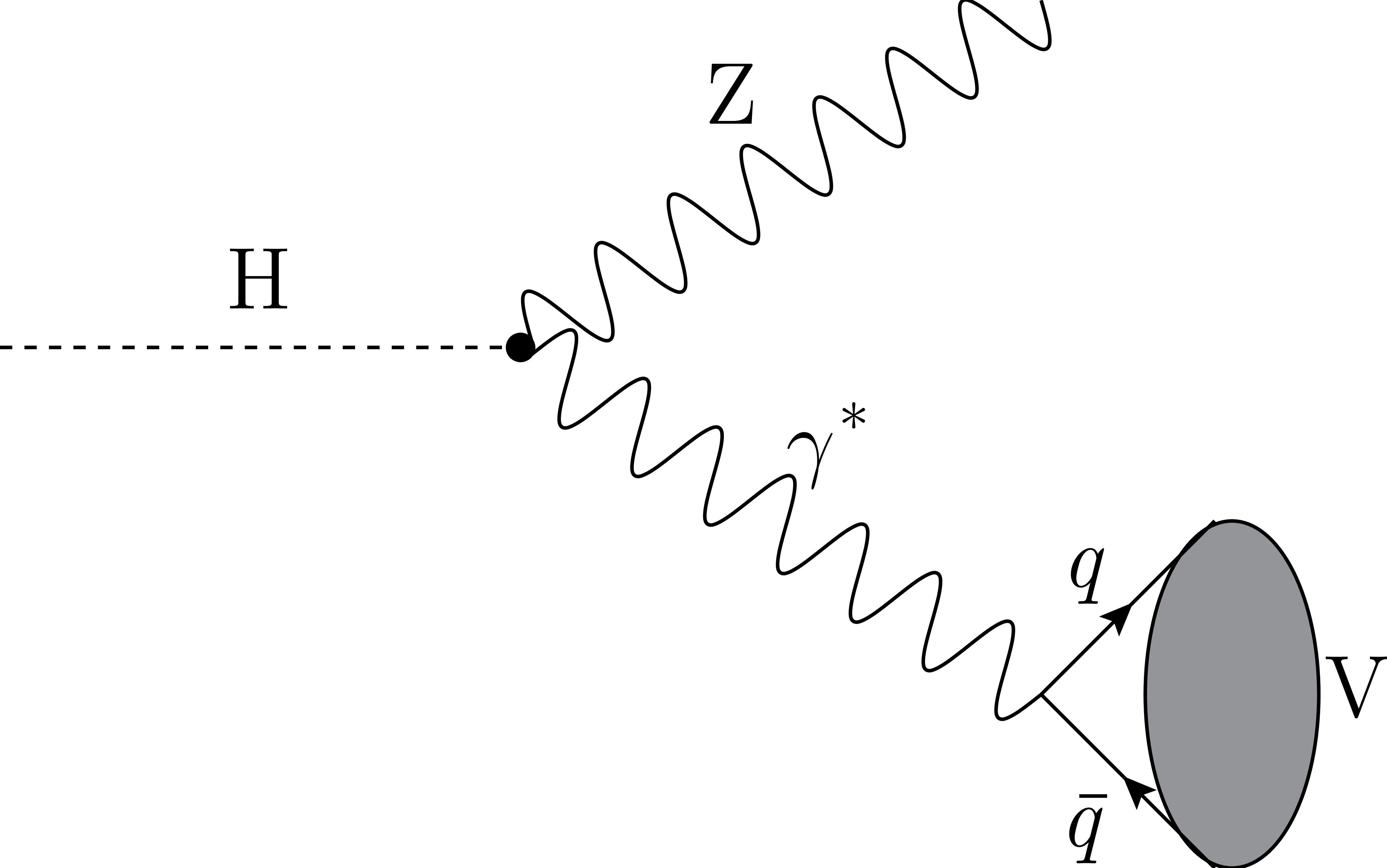
png pdf |
Figure 1-b:
Feynman diagram that contributes to the decay of a Higgs boson into a heavy vector boson and a vector meson. The grey oval shape represents the meson. This indirect process, where the meson originates from a $\gamma ^{*}$, is one of two that contribute the most to the total branching fraction in the SM. |
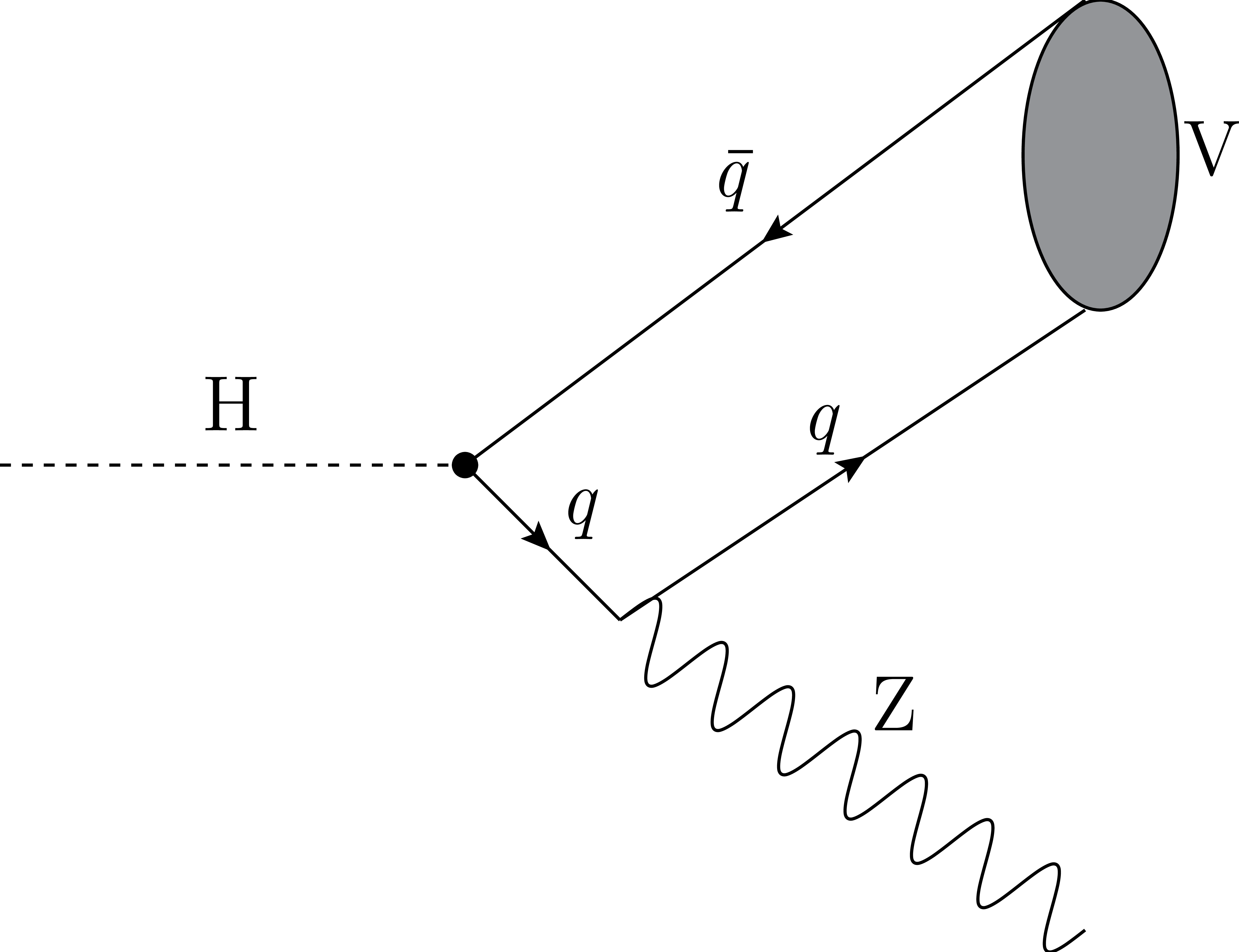
png pdf |
Figure 1-c:
Feynman diagram that contributes to the decay of a Higgs boson into a heavy vector boson and a vector meson. The grey oval shape represents the meson. |
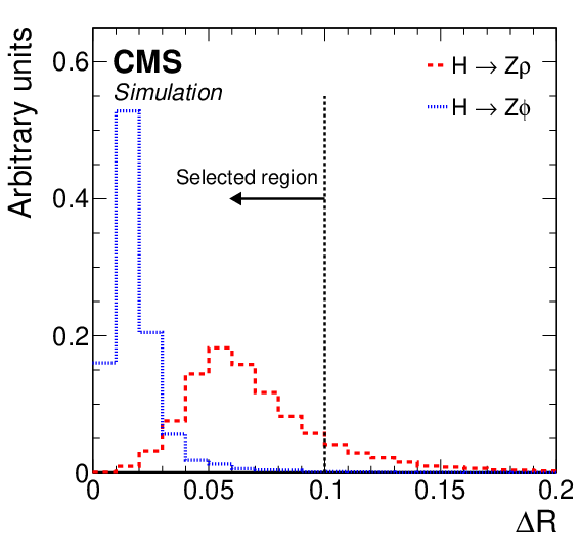
png pdf |
Figure 2:
The angular distance $\Delta R$ between the two tracks from the meson decay in $\mathrm{H} \to \mathrm{Z} \rho $ events (dashed red) and in $\mathrm{H} \to \mathrm{Z} \phi $ events (dotted blue). The separation is calculated between reconstructed tracks that are matched to the generator-level pions (kaons) to ensure that the tracks originate from the $\rho$ ($\phi$) decay. Both contributions are normalized to the same area. |

png pdf |
Figure 3:
The transverse momentum distribution for the track that has the larger ${p_{\mathrm {T}}}$ out of the two tracks selected as the $\rho$ or $\phi$ candidate. The distribution is shown for events that pass the meson candidate selection described in the text, but not the requirement that one of the tracks must have $ {p_{\mathrm {T}}} > $ 10 GeV. This distribution is shown for the $\mathrm{H} \to \mathrm{Z} \rho $ decay (dashed red), the $\mathrm{H} \to \mathrm{Z} \phi $ decay (dotted blue) and the background from Drell-Yan events (solid black). All contributions are normalized to the same area. |

png pdf |
Figure 4:
The ditrack isolation sum in the $\ell \ell \pi \pi $ (left) and $\ell \ell \mathrm{K} \mathrm{K} $ (right) channels, combining the $\mu \mu $ and ee channels for all the data-taking years. The distribution in data, as well as in the simulated $\mathrm{H} \to \mathrm{Z} \rho $ and $\mathrm{H} \to \mathrm{Z} \phi $ signals is shown. A branching fraction of 10 (5)% for the $\mathrm{H} \to \mathrm{Z} \rho $ ($\mathrm{H} \to \mathrm{Z} \phi $) signal is assumed. The isolation sum is shown after applying all selection criteria apart from the ditrack isolation requirement. The ditrack invariant mass requirement is also applied. Only events in which the dilepton plus ditrack invariant mass is in the range 120-130 GeV are considered. The dashed line indicates the boundary of the region used in the analysis, for which the isolation sum is required to be smaller than 0.5 GeV. |
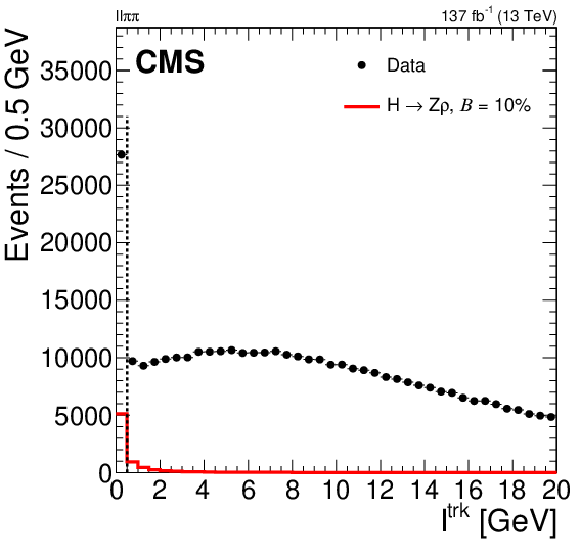
png pdf |
Figure 4-a:
The ditrack isolation sum in the $\ell \ell \pi \pi $ channel, combining the $\mu \mu $ and ee channels for all the data-taking years. The distribution in data, as well as in the simulated $\mathrm{H} \to \mathrm{Z} \rho $ signal is shown. A branching fraction of 10% for the $\mathrm{H} \to \mathrm{Z} \rho $ signal is assumed. The isolation sum is shown after applying all selection criteria apart from the ditrack isolation requirement. The ditrack invariant mass requirement is also applied. Only events in which the dilepton plus ditrack invariant mass is in the range 120-130 GeV are considered. The dashed line indicates the boundary of the region used in the analysis, for which the isolation sum is required to be smaller than 0.5 GeV. |
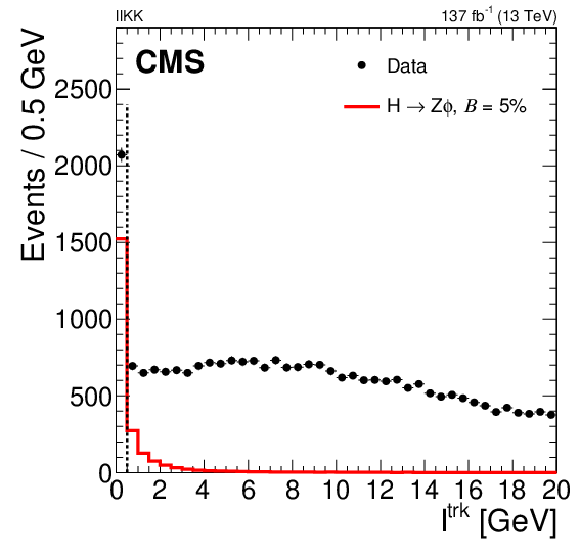
png pdf |
Figure 4-b:
The ditrack isolation sum in the $\ell \ell \mathrm{K} \mathrm{K} $ channel, combining the $\mu \mu $ and ee channels for all the data-taking years. The distribution in data, as well as in the simulated $\mathrm{H} \to \mathrm{Z} \phi $ signal is shown. A branching fraction of 5% for the $\mathrm{H} \to \mathrm{Z} \phi $ signal is assumed. The isolation sum is shown after applying all selection criteria apart from the ditrack isolation requirement. The ditrack invariant mass requirement is also applied. Only events in which the dilepton plus ditrack invariant mass is in the range 120-130 GeV are considered. The dashed line indicates the boundary of the region used in the analysis, for which the isolation sum is required to be smaller than 0.5 GeV. |
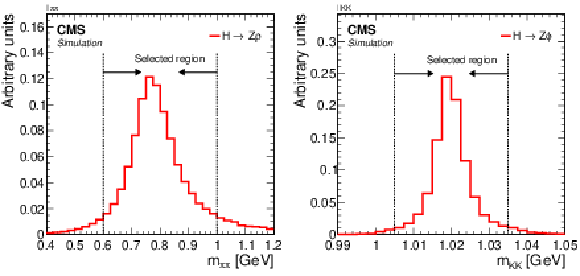
png pdf |
Figure 5:
Distribution of the ditrack invariant mass in simulated $\mathrm{H} \to \mathrm{Z} \rho $ events passing the $\ell \ell \pi \pi $ selection criteria (left) and in simulated $\mathrm{H} \to \mathrm{Z} \phi $ events passing the $\ell \ell \mathrm{K} \mathrm{K} $ selection criteria (right). These masses are calculated assuming the charged particle mass equals the pion mass in the $\ell \ell \pi \pi $ selection and assuming the charged particle mass equals the kaon mass in the $\ell \ell \mathrm{K} \mathrm{K} $ selection. The events pass all selection criteria described in the text, apart from the requirements on the ditrack invariant mass window. The dashed lines indicate the region selected in the analysis. |

png pdf |
Figure 5-a:
Distribution of the ditrack invariant mass in simulated $\mathrm{H} \to \mathrm{Z} \rho $ events passing the $\ell \ell \pi \pi $ selection criteria.These masses are calculated assuming the charged particle mass equals the pion mass. The events pass all selection criteria described in the text, apart from the requirements on the ditrack invariant mass window. The dashed lines indicate the region selected in the analysis. |
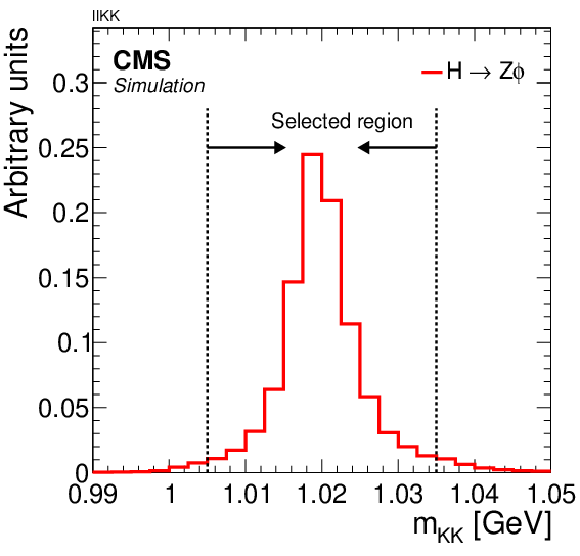
png pdf |
Figure 5-b:
Distribution of the ditrack invariant mass in simulated $\mathrm{H} \to \mathrm{Z} \rho $ events passing the $\ell \ell \pi \pi $ selection criteria. These masses are calculated assuming the charged particle mass equals the kaon mass. The events pass all selection criteria described in the text, apart from the requirements on the ditrack invariant mass window. The dashed lines indicate the region selected in the analysis. |
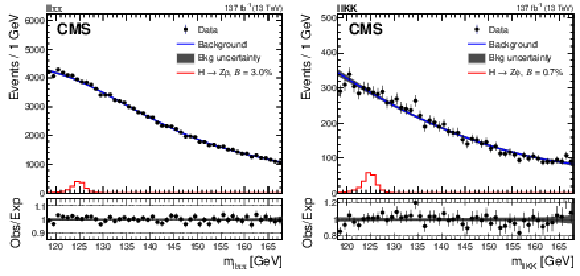
png pdf |
Figure 6:
Distributions of $m_{\ell \ell \pi \pi}$ (left) and $m_{\ell \ell \mathrm{K} \mathrm{K}}$ (right). For visualization the $\mu \mu $ and ee channels, as well as all three data-taking periods, are combined. Also shown are the $\mathrm{H} \to \mathrm{Z} \rho $ and $\mathrm{H} \to \mathrm{Z} \phi $ signals, in the isotropic-decay scenario and assuming branching fractions of 3.0 and 0.7%, respectively. The ratio between the data and the background model is shown in the lower panels. |
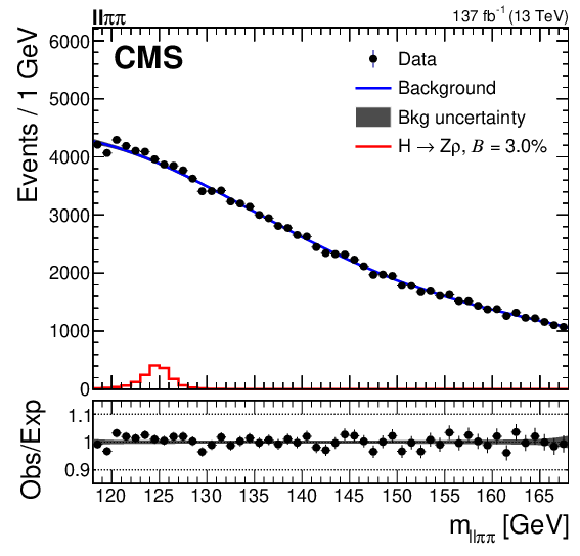
png pdf |
Figure 6-a:
Distribution of $m_{\ell \ell \pi \pi}$. For visualization the $\mu \mu $ and ee channels, as well as all three data-taking periods, are combined. Also shown is the $\mathrm{H} \to \mathrm{Z} \rho $ signal, in the isotropic-decay scenario and assuming branching fractions of 3.0% The ratio between the data and the background model is shown in the lower panel. |
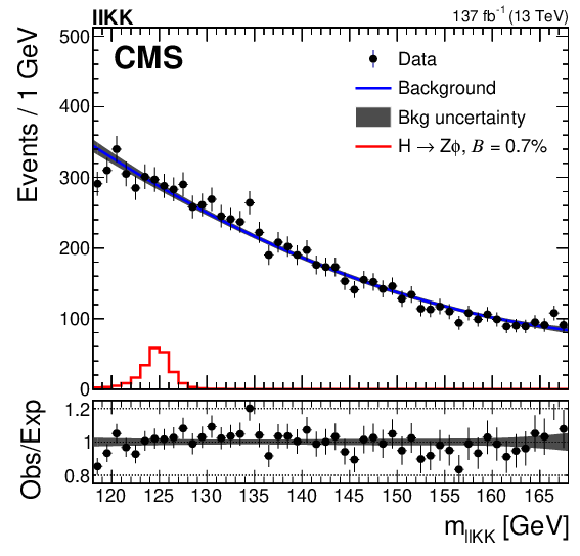
png pdf |
Figure 6-b:
Distribution of $m_{\ell \ell \mathrm{K} \mathrm{K}}$. For visualization the $\mu \mu $ and ee channels, as well as all three data-taking periods, are combined. Also shown is the $\mathrm{H} \to \mathrm{Z} \phi $ signal, in the isotropic-decay scenario and assuming branching fractions of 0.7% The ratio between the data and the background model is shown in the lower panel. |
| Tables | |

png pdf |
Table 1:
The effect on the signal yields of reweighting to the extreme polarization scenarios, described in more detail in the text, relative to the scenario with isotropic decays. The change in the fraction of signal events that pass the selection criteria affects the final results of the analysis. |

png pdf |
Table 2:
Effect of systematic uncertainties on the simulated signal. The ranges reflect differences between channels and data-taking periods. |

png pdf |
Table 3:
Observed and expected 95% CL upper limits on $\mathcal {B}(\mathrm{H} \to \mathrm{Z} \rho)$, for different polarizations. |

png pdf |
Table 4:
Observed and expected 95% CL upper limits on $\mathcal {B}(\mathrm{H} \to \mathrm{Z} \phi)$, for different polarizations. |
| Summary |
| A search has been presented for the rare decay of the Higgs boson (H) into a Z boson and a $\rho$ or a $\phi$ meson in the dilepton-$\pi^{+}\pi^{-}$ final states of the $\mathrm{H}zrho$ decay, and in the dilepton-$\mathrm{K^{+}}\mathrm{K^{-}}$ final states of the $\mathrm{H} \to \mathrm{Z}\phi$ decay. The search used a sample of proton-proton collisions, collected by the CMS experiment at a centre-of-mass energy of 13 TeV from 2016 to 2018 and corresponding to an integrated luminosity of 137 fb$^{-1}$. Upper limits on the branching fractions $\mathcal{B}(\mathrm{H} \to \mathrm{Z}\rho)$ and $\mathcal{B}(\mathrm{H} \to \mathrm{Z}\phi)$ have been set at the 95% confidence level for various polarization scenarios. The upper limits on $\mathcal{B}(\mathrm{H} \to \mathrm{Z}\rho)$ are in the range 1.04-1.31%, or 740-940 times the standard model expectation, while the upper limits on $\mathcal{B}(\mathrm{H} \to \mathrm{Z}\phi)$ range from 0.31 to 0.40%, or 730-950 times the standard model expectation. These results constitute the first experimental limits on the two decay channels. |
| Additional Figures | |
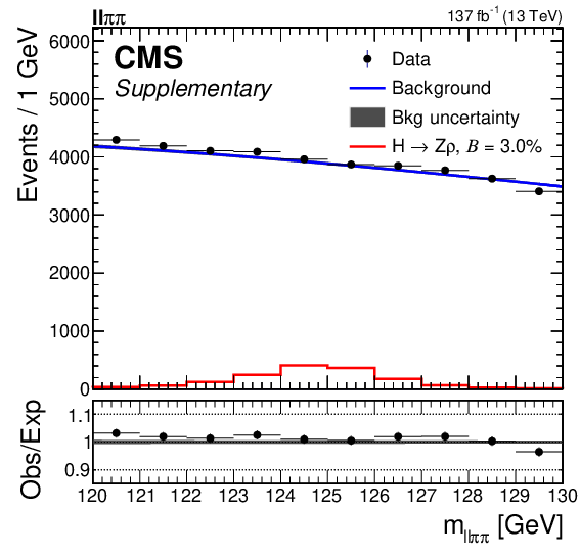
png pdf |
Additional Figure 1:
Distribution of $m_{\ell \ell {\pi} {\pi}}$, combining the dielectron and dimuon channels for all three data taking years. The $ {\mathrm {H}} \to {\mathrm {Z}} {\rho} $ signal, in the isotropic-decay scenario assuming a branching fraction of 3%, is also shown. This figure only shows the mass range containing most of the signal, which is a subset of the mass range used in the fit. |
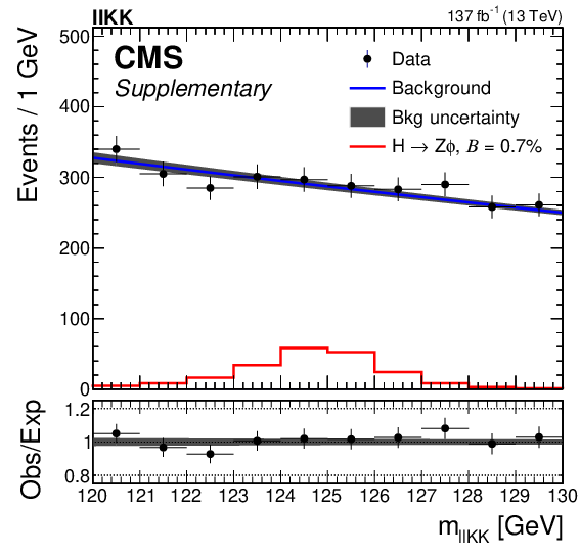
png pdf |
Additional Figure 2:
Distribution of $m_{\ell \ell {\mathrm {K}} {\mathrm {K}}}$, combining the dielectron and dimuon channels for all three data taking years. The $ {\mathrm {H}} \to {\mathrm {Z}} $ signal, in the isotropic-decay scenario assuming a branching fraction of 0.7%, is also shown. This figure only shows the mass range containing most of the signal, which is a subset of the mass range used in the fit. |

png pdf |
Additional Figure 3:
Observed and expected 95% CL upper limits on the branching ratio $\mathcal {B}({\mathrm {H}} \to {\mathrm {Z}} {\rho})$, for the different polarization scenarios considered. The Z boson and the $ {\rho} $ meson are either both transversely polarized (transverse) or both longitudinally polarized (longitudinal). The limits for each polarization scenario are obtained using the same data; differences in the limits arise only from changes in the expected signal yield. |

png pdf |
Additional Figure 4:
Observed and expected 95% CL upper limits on the branching ratio $\mathcal {B}({\mathrm {H}} \to {\mathrm {Z}})$, for the different polarization scenarios considered. The Z boson and the $\phi$ meson are either both transversely polarized (transverse) or both longitudinally polarized (longitudinal). The limits for each polarization scenario are obtained using the same data; differences in the limits arise only from changes in the expected signal yield. |
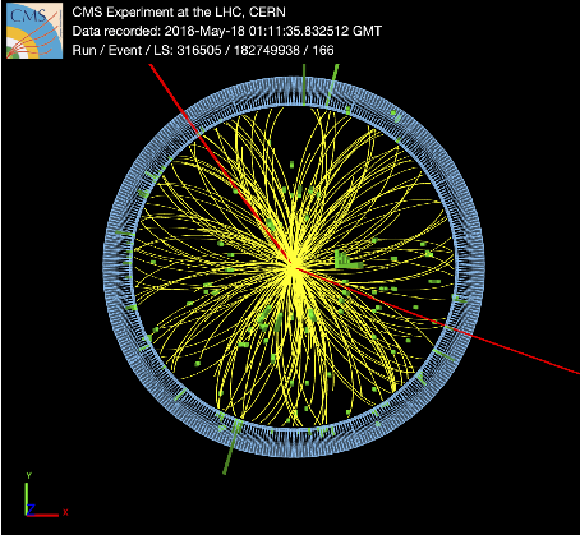
png pdf |
Additional Figure 5:
View of a candidate event with two muons (red lines) compatible with having originated from a Z boson, and two charged kaon tracks compatible with having originated from a $\phi$ meson. In this view all charged particle tracks in the event are shown. |

png pdf |
Additional Figure 6:
View of a candidate event with two muons (red lines) compatible with having originated from a Z boson, and two charged kaon tracks (yellow lines) compatible with having originated from a $\phi$ meson. In this view only the two charged kaon tracks are shown. |
| References | ||||
| 1 | ATLAS Collaboration | Observation of a new particle in the search for the standard model Higgs boson with the ATLAS detector at the LHC | PLB 716 (2012) 1 | 1207.7214 |
| 2 | CMS Collaboration | Observation of a new boson at a mass of 125 GeV with the CMS experiment at the LHC | PLB 716 (2012) 30 | CMS-HIG-12-028 1207.7235 |
| 3 | CMS Collaboration | Observation of a new boson with mass near 125 GeV in pp collisions at $ \sqrt{s} = $ 7 and 8 TeV | JHEP 06 (2013) 081 | CMS-HIG-12-036 1303.4571 |
| 4 | F. Englert and R. Brout | Broken symmetry and the mass of gauge vector mesons | PRL 13 (1964) 321 | |
| 5 | P. W. Higgs | Broken symmetries, massless particles and gauge fields | PL12 (1964) 132 | |
| 6 | P. W. Higgs | Broken symmetries and the masses of gauge bosons | PRL 13 (1964) 508 | |
| 7 | G. S. Guralnik, C. R. Hagen, and T. W. B. Kibble | Global conservation laws and massless particles | PRL 13 (1964) 585 | |
| 8 | P. W. Higgs | Spontaneous symmetry breakdown without massless bosons | PR145 (1966) 1156 | |
| 9 | T. W. B. Kibble | Symmetry breaking in non-abelian gauge theories | PR155 (1967) 1554 | |
| 10 | ATLAS Collaboration | Measurement of Higgs boson production in the diphoton decay channel in pp collisions at center-of-mass energies of 7 and 8 TeV with the ATLAS detector | PRD 90 (2014) 112015 | 1408.7084 |
| 11 | CMS Collaboration | Observation of the diphoton decay of the Higgs boson and measurement of its properties | EPJC 74 (2014) 3076 | CMS-HIG-13-001 1407.0558 |
| 12 | ATLAS Collaboration | Measurements of Higgs boson production and couplings in the four-lepton channel in pp collisions at center-of-mass energies of 7 and 8 TeV with the ATLAS detector | PRD 91 (2015) 012006 | 1408.5191 |
| 13 | CMS Collaboration | Measurement of the properties of a Higgs boson in the four-lepton final state | PRD 89 (2014) 092007 | CMS-HIG-13-002 1312.5353 |
| 14 | ATLAS Collaboration | Observation and measurement of Higgs boson decays to WW$ ^* $ with the ATLAS detector | PRD 92 (2015) 012006 | 1412.2641 |
| 15 | ATLAS Collaboration | Study of (W/Z)H production and Higgs boson couplings using $ H \rightarrow WW^{\ast} $ decays with the ATLAS detector | JHEP 08 (2015) 137 | 1506.06641 |
| 16 | CMS Collaboration | Measurement of Higgs boson production and properties in the WW decay channel with leptonic final states | JHEP 01 (2014) 096 | CMS-HIG-13-023 1312.1129 |
| 17 | ATLAS and CMS Collaborations | Measurements of the Higgs boson production and decay rates and constraints on its couplings from a combined ATLAS and CMS analysis of the LHC pp collision data at $ \sqrt{s}= $ 7 and 8 TeV | JHEP 08 (2016) 045 | 1606.02266 |
| 18 | ATLAS Collaboration | Cross-section measurements of the Higgs boson decaying into a pair of $ \tau $-leptons in proton-proton collisions at $ \sqrt{s}= $ 13 TeV with the ATLAS detector | PRD 99 (2019) 072001 | 1811.08856 |
| 19 | CMS Collaboration | Observation of the Higgs boson decay to a pair of $ \tau $ leptons with the CMS detector | PLB 779 (2018) 283 | CMS-HIG-16-043 1708.00373 |
| 20 | ATLAS Collaboration | Observation of Higgs boson production in association with a top quark pair at the LHC with the ATLAS detector | PLB 784 (2018) 173 | 1806.00425 |
| 21 | CMS Collaboration | Observation of $ \mathrm{t\overline{t}} $H production | PRL 120 (2018) 231801 | CMS-HIG-17-035 1804.02610 |
| 22 | ATLAS Collaboration | Observation of $ H \rightarrow b\bar{b} $ decays and $ VH $ production with the ATLAS detector | PLB 786 (2018) 59 | 1808.08238 |
| 23 | CMS Collaboration | Observation of Higgs boson decay to bottom quarks | PRL 121 (2018) 121801 | CMS-HIG-18-016 1808.08242 |
| 24 | ATLAS Collaboration | Search for the dimuon decay of the Higgs boson in $ pp $ collisions at $ \sqrt{s} = $ 13 TeV with the ATLAS detector | PRL 119 (2017) 051802 | 1705.04582 |
| 25 | CMS Collaboration | Search for the Higgs boson decaying to two muons in proton-proton collisions at $ \sqrt{s} = $ 13 TeV | PRL 122 (2019) 021801 | CMS-HIG-17-019 1807.06325 |
| 26 | ATLAS Collaboration | Search for the decay of the Higgs boson to charm quarks with the ATLAS experiment | PRL 120 (2018) 211802 | 1802.04329 |
| 27 | CMS Collaboration | A search for the standard model Higgs boson decaying to charm quarks | JHEP 03 (2020) 131 | CMS-HIG-18-031 1912.01662 |
| 28 | G. T. Bodwin, F. Petriello, S. Stoynev, and M. Velasco | Higgs boson decays to quarkonia and the $ H\bar{c}c $ coupling | PRD 88 (2013) 053003 | 1306.5770 |
| 29 | A. L. Kagan et al. | Exclusive window onto Higgs Yukawa couplings | PRL 114 (2015) 101802 | 1406.1722 |
| 30 | S. Alte, M. Konig, and M. Neubert | Exclusive weak radiative Higgs decays in the standard model and beyond | JHEP 12 (2016) 037 | 1609.06310 |
| 31 | CMS Collaboration | Search for rare decays of Z and Higgs bosons to J$ /\psi $ and a photon in proton-proton collisions at $ \sqrt{s} = $ 13 TeV | EPJC 79 (2019) 94 | CMS-SMP-17-012 1810.10056 |
| 32 | ATLAS Collaboration | Searches for exclusive Higgs and $ Z $ boson decays into $ J/\psi\gamma $, $ \psi(\text{2S})\gamma $, and $ \Upsilon(\text{nS})\gamma $ at $ \sqrt{s}= $ 13 TeV with the ATLAS detector | PLB 786 (2018) 134 | 1807.00802 |
| 33 | ATLAS Collaboration | Search for exclusive Higgs and $ Z $ boson decays to $ \phi\gamma $ and $ \rho\gamma $ with the ATLAS detector | JHEP 07 (2018) 127 | 1712.02758 |
| 34 | D. de Florian et al. | Handbook of LHC Higgs cross sections: 4. Deciphering the nature of the Higgs sector | CERN-2017-002-M | 1610.07922 |
| 35 | G. Isidori, A. V. Manohar, and M. Trott | Probing the nature of the Higgs-like boson via $ h \to v \mathcal{F} $ decays | PLB 728 (2014) 131 | 1305.0663 |
| 36 | ATLAS Collaboration | Search for Higgs boson decays into a $ Z $ boson and a light hadronically decaying resonance using 13 TeV pp collision data from the ATLAS detector | Submitted to PRLett | 2004.01678 |
| 37 | G. F. Giudice and O. Lebedev | Higgs-dependent Yukawa couplings | PLB 665 (2008) 79 | 0804.1753 |
| 38 | F. Bishara, J. Brod, P. Uttayarat, and J. Zupan | Nonstandard Yukawa couplings and Higgs portal dark matter | JHEP 01 (2016) 010 | 1504.04022 |
| 39 | C. D. Froggatt and H. B. Nielsen | Hierarchy of quark masses, Cabibbo angles and CP violation | NPB 147 (1979) 277 | |
| 40 | M. Leurer, Y. Nir, and N. Seiberg | Mass matrix models: The sequel | NPB 420 (1994) 468 | hep-ph/9310320 |
| 41 | L. Randall and R. Sundrum | A large mass hierarchy from a small extra dimension | PRL 83 (1999) 3370 | hep-ph/9905221 |
| 42 | CMS Collaboration | Description and performance of track and primary-vertex reconstruction with the CMS tracker | JINST 9 (2014) P10009 | CMS-TRK-11-001 1405.6569 |
| 43 | CMS Collaboration | Performance of the CMS muon detector and muon reconstruction with proton-proton collisions at $ \sqrt{s} = $ 13 TeV | JINST 13 (2018) P06015 | CMS-MUO-16-001 1804.04528 |
| 44 | CMS Collaboration | Performance of electron reconstruction and selection with the CMS detector in proton-proton collisions at $ \sqrt{s} = $ 8 TeV | JINST 10 (2015) P06005 | CMS-EGM-13-001 1502.02701 |
| 45 | CMS Collaboration | The CMS trigger system | JINST 12 (2017) P01020 | CMS-TRG-12-001 1609.02366 |
| 46 | CMS Collaboration | The CMS experiment at the CERN LHC | JINST 3 (2008) S08004 | CMS-00-001 |
| 47 | CMS Collaboration | Particle-flow reconstruction and global event description with the CMS detector | JINST 12 (2017) P10003 | CMS-PRF-14-001 1706.04965 |
| 48 | M. Cacciari, G. P. Salam, and G. Soyez | The anti-$ {k_{\mathrm{T}}} $ jet clustering algorithm | JHEP 04 (2008) 063 | 0802.1189 |
| 49 | M. Cacciari, G. P. Salam, and G. Soyez | FastJet user manual | EPJC 72 (2012) 1896 | 1111.6097 |
| 50 | P. Nason | A new method for combining NLO QCD with shower Monte Carlo algorithms | JHEP 11 (2004) 040 | hep-ph/0409146 |
| 51 | S. Frixione, P. Nason, and C. Oleari | Matching NLO QCD computations with parton shower simulations: the POWHEG method | JHEP 11 (2007) 070 | 0709.2092 |
| 52 | S. Alioli, P. Nason, C. Oleari, and E. Re | NLO Higgs boson production via gluon fusion matched with shower in POWHEG | JHEP 04 (2009) 002 | 0812.0578 |
| 53 | S. Alioli, P. Nason, C. Oleari, and E. Re | A general framework for implementing NLO calculations in shower Monte Carlo programs: the POWHEG BOX | JHEP 06 (2010) 043 | 1002.2581 |
| 54 | P. Nason and C. Oleari | NLO Higgs boson production via vector-boson fusion matched with shower in POWHEG | JHEP 02 (2010) 037 | 0911.5299 |
| 55 | G. Luisoni, P. Nason, C. Oleari, and F. Tramontano | HW$ ^{\pm} $/HZ + 0 and 1 jet at NLO with the POWHEG BOX interfaced to GoSam and their merging within MiNLO | JHEP 10 (2013) 083 | 1306.2542 |
| 56 | J. Alwall et al. | The automated computation of tree-level and next-to-leading order differential cross sections, and their matching to parton shower simulations | JHEP 07 (2014) 079 | 1405.0301 |
| 57 | T. Sjostrand et al. | An introduction to PYTHIA 8.2 | CPC 191 (2015) 159 | 1410.3012 |
| 58 | NNPDF Collaboration | Parton distributions for the LHC run II | JHEP 04 (2015) 040 | 1410.8849 |
| 59 | NNPDF Collaboration | Parton distributions from high-precision collider data | EPJC 77 (2017) 663 | 1706.00428 |
| 60 | CMS Collaboration | Event generator tunes obtained from underlying event and multiparton scattering measurements | EPJC 76 (2016) 155 | CMS-GEN-14-001 1512.00815 |
| 61 | CMS Collaboration | Extraction and validation of a new set of CMS PYTHIA8 tunes from underlying-event measurements | EPJC 80 (2020) 4 | CMS-GEN-17-001 1903.12179 |
| 62 | \GEANTfour Collaboration | GEANT4--a simulation toolkit | NIMA 506 (2003) 250 | |
| 63 | Particle Data Group, M. Tanabashi et al. | Review of particle physics | PRD 98 (2018) 030001 | |
| 64 | CMS Collaboration | Measurement of the inelastic proton-proton cross section at $ \sqrt{s}= $ 13 TeV | JHEP 07 (2018) 161 | CMS-FSQ-15-005 1802.02613 |
| 65 | CMS Collaboration | Measurements of inclusive $ \mathrm{W} $ and $ \mathrm{Z} $ cross sections in $ {\mathrm{p}}{\mathrm{p}} $ collisions at $ \sqrt{s}= $ 7 TeV | JHEP 01 (2011) 080 | CMS-EWK-10-002 1012.2466 |
| 66 | J. H. Broughton | Searches for Rare Exclusive Higgs Boson Decays to a Meson and an Associated Photon with the ATLAS Detector” | PhD thesis, Birmingham U. | |
| 67 | R. D. Fisher | On the interpretation of $ \chi^2 $ from contingency tables, and the calculation of P | J. Royal Stat. Soc. 85 (1922) 87 | |
| 68 | CMS Collaboration | Search for narrow and broad dijet resonances in proton-proton collisions at $ \sqrt{s}= $ 13 TeV and constraints on dark matter mediators and other new particles | JHEP 08 (2018) 130 | CMS-EXO-16-056 1806.00843 |
| 69 | T. Junk | Confidence level computation for combining searches with small statistics | NIMA 434 (1999) 435 | hep-ex/9902006 |
| 70 | A. L. Read | Presentation of search results: The CL$ _{\text{s}} $ technique | JPG 28 (2002) 2693 | |
| 71 | The ATLAS Collaboration, The CMS Collaboration, The LHC Higgs Combination Group | Procedure for the LHC Higgs boson search combination in Summer 2011 | CMS-NOTE-2011-005 | |
| 72 | G. Cowan, K. Cranmer, E. Gross, and O. Vitells | Asymptotic formulae for likelihood-based tests of new physics | EPJC 71 (2011) 1554 | 1007.1727 |
| 73 | CMS Collaboration | CMS luminosity measurements for the 2016 data taking period | CMS-PAS-LUM-17-001 | CMS-PAS-LUM-17-001 |
| 74 | CMS Collaboration | CMS luminosity measurement for the 2017 data-taking period at $ \sqrt{s} = $ 13 TeV | CMS-PAS-LUM-17-004 | CMS-PAS-LUM-17-004 |
| 75 | CMS Collaboration | CMS luminosity measurement for the 2018 data-taking period at $ \sqrt{s} = $ 13 TeV | CMS-PAS-LUM-18-002 | CMS-PAS-LUM-18-002 |

|
Compact Muon Solenoid LHC, CERN |

|

|

|

|

|

|